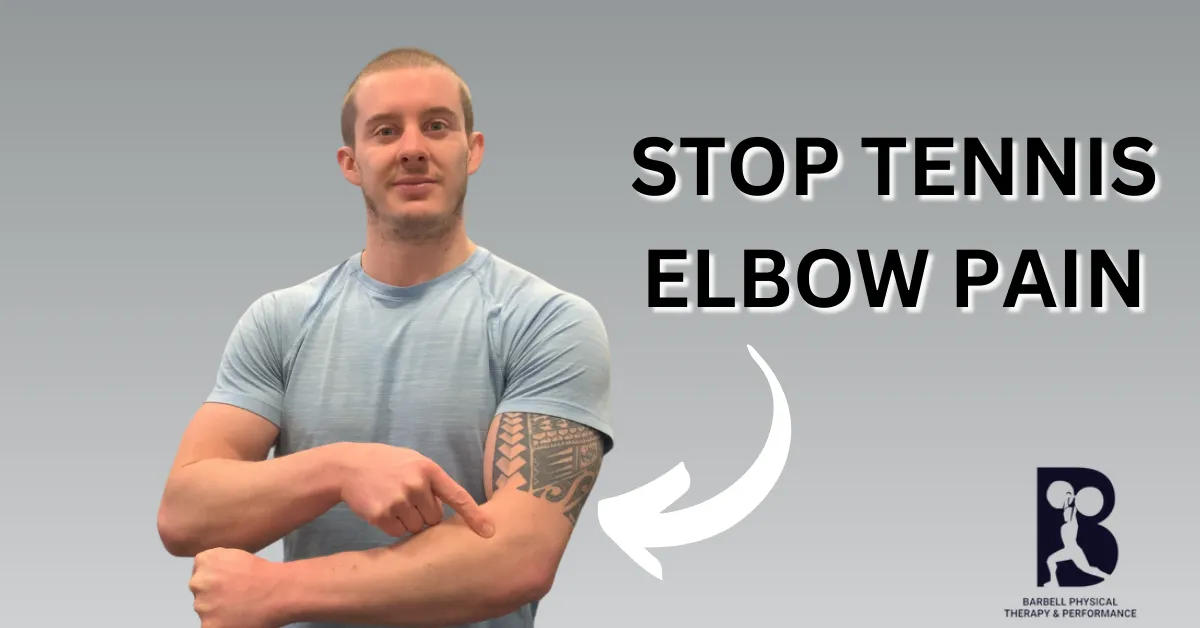Do you have pain on the outside of your elbow that is worse with pull-ups, deadlifts, and other grip-intensive activities like picking up a suitcase or backpack?
If you do, then you might be dealing with lateral epicondylalgia, which is more commonly known as tennis elbow.
Tennis elbow is a type of overuse injury that affects the common extensor origin on the outside of the elbow, including the extensor carpi radialis brevis and longus, extensor digitorum, extensor digiti minimi, and extensor carpi ulnaris. These muscles are mainly responsible for extending the wrist and fingers, but are also implicated in the overall process of gripping.
When you’re trying to fix a case of tennis elbow, there are two main things that you need to focus on.
The first is building up the local strength, endurance, and tissue tolerance of the muscles on the outside of the elbow.
The second is addressing the strength and endurance of the shoulder muscles.
Now, we are going to cover the 3 exercises that we most commonly use to help our patients who are dealing with tennis elbow.
Loaded Wrist Extension
The first exercise is loaded wrist extension. This exercise directly loads the wrist and finger extensors, and is arguably the most important exercise to perform to fix tennis elbow.
To perform this exercise, you want to be standing or sitting with your forearm supported on a surface and your elbow bent, and your hand hanging freely off the edge. Holding a weight in your hand, you are going to raise your hand up towards the ceiling, extending your wrist, before returning back to the starting position.
As a general rule of thumb, you want to use a weight that makes it challenging to hit 8-15 reps in a set.
If you’re elbow is extremely irritable and flared up with exercise, this exercise can be regressed by performing isometric wrist extension, in which you simply hold your wrist in neutral and try to push it down towards the floor with the opposite hand, holding this contraction for 3-5 sets of 30-45 seconds.
You can also progress this exercise by using heavier loads, or increasing the speed of the movement to increase the amount of force that your wrist and finger extensors have to produce.
Loaded Wrist Supination
The second exercise is loaded wrist supination. This exercise works a muscle called the supinator, which is located in a similar area as the wrist and finger extensors.
To perform this exercise you are going to hold a PVC pipe, dowel, or broomstick in your hand with your forearm supported, and slowly lower the top end of the instrument towards the floor, before returning to the starting position.
To make this harder, you can hold the PVC pipe, broomstick, or dowel closer towards the end, or to make it easier, you can hold it closer to the middle.
This exercise should also be performed for 8-15 reps per set. If this eventually becomes too easy with a PVC pipe or other similar tool, you can perform this movement with a kettlebell.
The third exercise is one that doesn’t directly train the wrist and finger extensors, but rather the muscles of the shoulder. This is because research has shown that including exercises for the upper back and shoulder ALONG with exercises for the elbow produces better results than JUST exercises for the elbow.
Prone W
The exercise that we’re going to use here is the prone W, as it trains the upper back, posterior shoulder, and posterior rotator cuff all at the same time.
To perform this exercise, you are going to lie face down on the floor or on a bench, with your shoulders abducted to 90 degrees and elbows bent to 90 degrees. From here, you are going to raise your entire arm up towards the ceiling, pause for a second, and then return to the starting position.
This exercise should also typically be performed for sets of 8-15 reps, and if this is too easy with just bodyweight, you can hold small plates or dumbbells in your hands to increase the difficulty.



